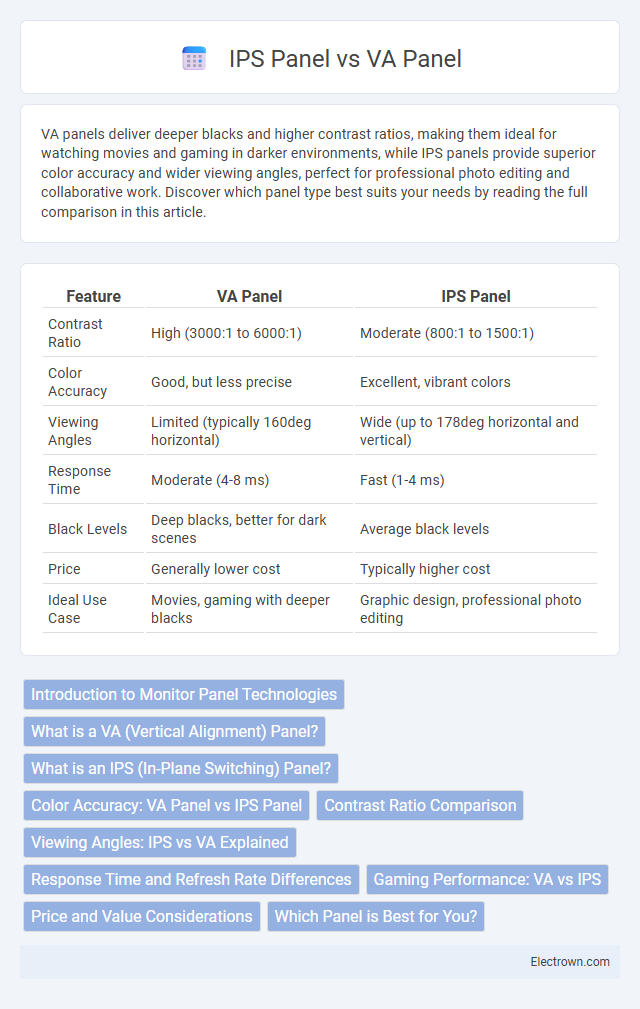VA panels deliver deeper blacks and higher contrast ratios, making them ideal for watching movies and gaming in darker environments, while IPS panels provide superior color accuracy and wider viewing angles, perfect for professional photo editing and collaborative work. Discover which panel type best suits your needs by reading the full comparison in this article.
Table of Comparison
| Feature | VA Panel | IPS Panel |
|---|---|---|
| Contrast Ratio | High (3000:1 to 6000:1) | Moderate (800:1 to 1500:1) |
| Color Accuracy | Good, but less precise | Excellent, vibrant colors |
| Viewing Angles | Limited (typically 160deg horizontal) | Wide (up to 178deg horizontal and vertical) |
| Response Time | Moderate (4-8 ms) | Fast (1-4 ms) |
| Black Levels | Deep blacks, better for dark scenes | Average black levels |
| Price | Generally lower cost | Typically higher cost |
| Ideal Use Case | Movies, gaming with deeper blacks | Graphic design, professional photo editing |
Introduction to Monitor Panel Technologies
VA panels offer superior contrast ratios and deeper blacks by using vertically aligned liquid crystals, making them ideal for dark room environments and high contrast visuals. IPS panels provide wider viewing angles and more accurate color reproduction due to their in-plane switching technology, making them favored for professional photo and video editing. Choosing between VA and IPS panels depends on the need for contrast depth versus color accuracy and viewing angles.
What is a VA (Vertical Alignment) Panel?
A VA (Vertical Alignment) panel is a type of LCD screen technology characterized by liquid crystals that align vertically when the display is off, enhancing contrast ratios and producing deeper blacks compared to IPS panels. VA panels offer superior contrast levels, often exceeding 3000:1, making them ideal for dark-room viewing and content with high contrast demands. They tend to have slower response times and narrower viewing angles than IPS (In-Plane Switching) panels, which impacts the viewing experience in multi-angle scenarios.
What is an IPS (In-Plane Switching) Panel?
An IPS (In-Plane Switching) panel is a type of LCD display technology that offers superior color accuracy and wide viewing angles compared to VA panels. It achieves this by aligning liquid crystals parallel to the screen, allowing consistent color reproduction and minimal distortion from different viewing positions. IPS panels are commonly preferred for professional graphic design, photo editing, and any application requiring precise color fidelity.
Color Accuracy: VA Panel vs IPS Panel
VA panels offer higher contrast ratios and deeper blacks, but typically have lower color accuracy compared to IPS panels. IPS panels provide superior color accuracy and wider viewing angles, making them ideal for tasks requiring precise color representation such as photo editing and graphic design. When choosing your display, prioritize IPS if accurate color reproduction is crucial for your work or entertainment.
Contrast Ratio Comparison
VA panels typically offer superior contrast ratios, often exceeding 3000:1, which delivers deeper blacks and more vibrant images compared to IPS panels that generally range around 1000:1. This difference in contrast ratio makes VA panels ideal for environments requiring better shadow detail and darker scenes, enhancing your viewing experience. While IPS panels excel in color accuracy and viewing angles, VA panels are preferred when contrast ratio is a top priority.
Viewing Angles: IPS vs VA Explained
IPS panels offer wider viewing angles, typically up to 178 degrees, maintaining consistent color accuracy and brightness when viewed from the side. VA panels have narrower viewing angles, around 160 degrees, which can result in noticeable color shifting and contrast loss at oblique angles. This characteristic makes IPS displays superior for environments where multiple viewers or off-center viewing is common.
Response Time and Refresh Rate Differences
VA panels typically have slower response times compared to IPS panels, resulting in more motion blur during fast-paced scenes. IPS panels offer faster response times, often around 1-4 milliseconds, which enhances clarity in gaming and video playback. Refresh rates on both panel types can range up to 144Hz or higher for gaming monitors, but IPS panels maintain smoother motion with less ghosting due to their quicker pixel transitions.
Gaming Performance: VA vs IPS
VA panels offer deeper contrast ratios and better black levels, enhancing immersion in darker game scenes, while IPS panels provide faster response times and wider viewing angles, reducing motion blur and ghosting in fast-paced games. For competitive gaming, IPS panels typically deliver smoother gameplay due to quicker pixel response, whereas VA panels excel in visual quality with richer colors and contrast. Your choice depends on whether you prioritize speed and color accuracy (IPS) or contrast and depth (VA) for your gaming experience.
Price and Value Considerations
VA panels generally offer better price-to-performance value due to their lower manufacturing costs and higher contrast ratios, making them ideal for budget-conscious users prioritizing deep blacks and high contrast. IPS panels typically come at a higher price point but justify the cost with superior color accuracy, wider viewing angles, and faster response times, benefiting professionals and gamers seeking precise visuals. Consumers must weigh their priorities between affordability and premium display quality when choosing between VA and IPS technology.
Which Panel is Best for You?
VA panels offer higher contrast ratios and deeper blacks, making them ideal for watching movies and gaming in dark rooms. IPS panels provide better color accuracy and wider viewing angles, suited for professional photo editing and collaborative workspaces. Your choice depends on whether you prioritize contrast and black levels or color fidelity and viewing angles.
VA Panel vs IPS Panel Infographic

 electrown.com
electrown.com